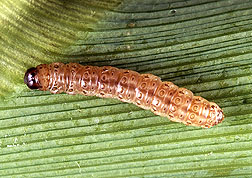This page has been archived and is being provided for reference purposes only. The page is no longer being updated, and therefore, links on the page may be invalid.
New Study Shows Benefits of Bt Corn to Farmers
By Jan Suszkiw
October 7, 2010
WASHINGTON—A group of agricultural scientists reported in today's issue of the journal Science that corn that has been genetically engineered to produce insect-killing proteins isolated from the soil bacterium Bacillus thuringiensis (Bt) provides significant economic benefits even to neighboring farmers who grow non-transgenic varieties of corn.
"Modern agricultural science is playing a critical role in addressing many of the toughest issues facing American agriculture today, including pest management and productivity," said Agriculture Secretary Tom Vilsack. "This study provides important information about the benefits of biotechnology by directly examining how area-wide suppression of corn borers using Bt corn can improve yield and grain quality even of non-Bt varieties."
The researchers estimate that farmers in Iowa, Illinois, Minnesota, Nebraska and Wisconsin received cumulative economic benefits of nearly $7 billion between 1996-2009, with benefits of more than $4 billion for non-Bt corn farmers alone. The scientists estimated that in Minnesota, Illinois and Wisconsin, borer populations in adjacent non-Bt fields declined by 28 to 73 percent, with similar reductions recorded in Iowa and Nebraska.
The researchers attribute the collateral benefits enjoyed by non-Bt farmers to areawide suppression of corn borers stemming from long-term plantings of Bt-protected crops. Potato, green bean and other host crops also stand to benefit from areawide reductions of corn borers, the researchers note. The team's Science report also highlights the importance of the use of refuge crops—the planting of non-Bt crops adjacent to fields of Bt crops, providing a refuge to which the pests can retreat—and other strategies to slow the corn borer's ability to develop resistance to Bt and thus maintain the insecticidal proteins' long-term effectiveness.
The Bt proteins provide the plant with a built-in defense against attacks by the larvae of European corn borers and other insect pests. Larvae that ingest the protein soon stop feeding and die, typically within 48 hours. In addition to reducing the use of insecticides that also can endanger beneficial insects, the Bt defense strategy helps prevent harmful molds from gaining entry to the plants via wound sites from borer feeding. Some of these molds, like Fusarium, produce mycotoxins that can diminish the value and safety of the crop's kernels.
Bt corn debuted in 1996, and by 2009 was planted on nearly 55 million acres in the United States, accounting for nearly 63 percent of the total U.S. corn crop of 87 million acres. But no research groups had previously investigated the long-term impact of such plantings on corn borer populations on a regional scale, nor had there been any assessment of whether the use of the crop provided any sort of collateral benefit to adjacent or nearby fields of non-Bt crops.
The team was led by William Hutchison of the University of Minnesota and included Rick Hellmich, a U.S. Department of Agriculture (USDA) entomologist at the Corn Insects and Crop Genetics Research Unit operated at Ames, Iowa, by the Agricultural Research Service (ARS). ARS is USDA's principal intramural scientific research agency. The team gathered 14 years' worth of corn borer population data from Bt corn plantings and combined it with national corn production figures, including yields, prices and acreage planted.
In addition to ARS and the University of Minnesota, study participants included researchers from the University of Wisconsin at Madison, Pennsylvania State University at State College, the University of Illinois at Urbana, the University of Nebraska at Lincoln, Iowa State University at Nashua, and industry researchers, among others.

